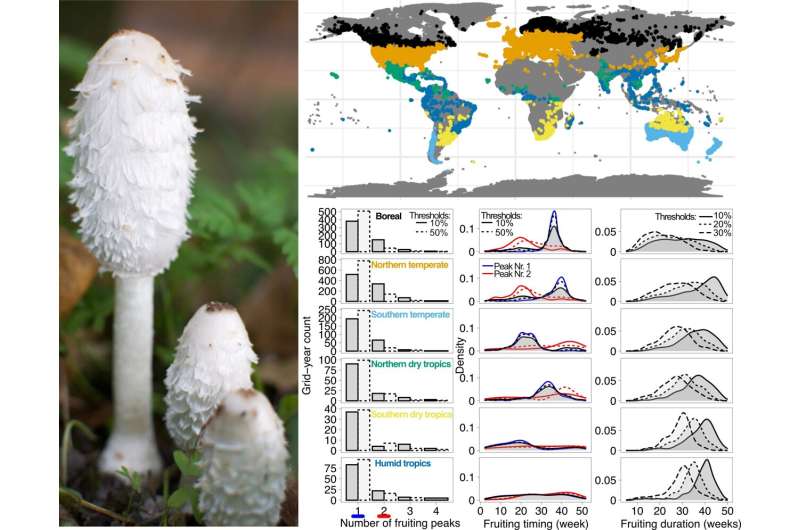This article has been reviewed according to Science X's editorial process and policies. Editors have highlighted the following attributes while ensuring the content's credibility:
fact-checked
peer-reviewed publication
trusted source
proofread
More than 6 million data points prove the influence of climate on global fungal occurrence

A new study by Bayreuth scientists has shown that temperature has a significant influence on the timing and duration of fungal fruiting in key areas of the world. The research results were published in the journal Ecology Letters and shed new light on the global impact of climate change on occurrences of fungi in nature.
Earth's ecosystems are being altered by a complex interaction of the animate and inanimate environment. However, the effects of rising global temperatures due to climate change on the fruiting body formation of fungi during the course of the year on a global scale had not been explored until now.
To better understand this phenomenon, Prof. Dr. Claus Bässler, Professor of Fungal Ecology at the University of Bayreuth, and Dr. Franz-Sebastian Krah, Academic Advisor at the Chair of Fungal Ecology, have analyzed 6.1 million data points in time and space of fungal fruiting bodies worldwide. A data point is the occurrence of a fruiting body in time and space, i.e., a date with a coordinate.
The results show that there are climatic zones in which the main times of mushroom fruiting in spring and autumn are spatially synchronized (this includes Germany, for example), while other climatic zones (such as the ever-humid tropics) show spatially variable and non-synchronized fruiting. In addition, the researchers found that the timing and duration of fungal fruiting is significantly related to temperature, while precipitation has little influence.
"These findings suggest that the spatial and temporal distribution of fungal fruiting body formation will change if global temperatures continue to rise," says Prof. Dr. Claus Bässler. "This can have far-reaching effects on various sectors, such as forestry, where productivity depends on fungi, among other things." Organisms never exist in isolation, but are together with others in finely tuned ecological and evolutionary relationships.
"This also means in concrete terms that mushrooms will soon no longer necessarily be in season in our country in autumn, but will only grow in December, or that seasonal patterns will dissolve altogether," says Dr. Franz-Sebastian Krah. "We still know little about the interaction of fungi with other organisms. But there is definitely a risk of unpredictable changes in this regard."
The two scientists from the University of Bayreuth are the first to study fungal occurrences over the course of the year on a global scale. Until now, there have only been individual studies from spatially small areas.
More information: Franz‐Sebastian Krah et al, Temperature affects the timing and duration of fungal fruiting patterns across major terrestrial biomes, Ecology Letters (2023). DOI: 10.1111/ele.14275
Journal information: Ecology Letters
Provided by Bayreuth University




















